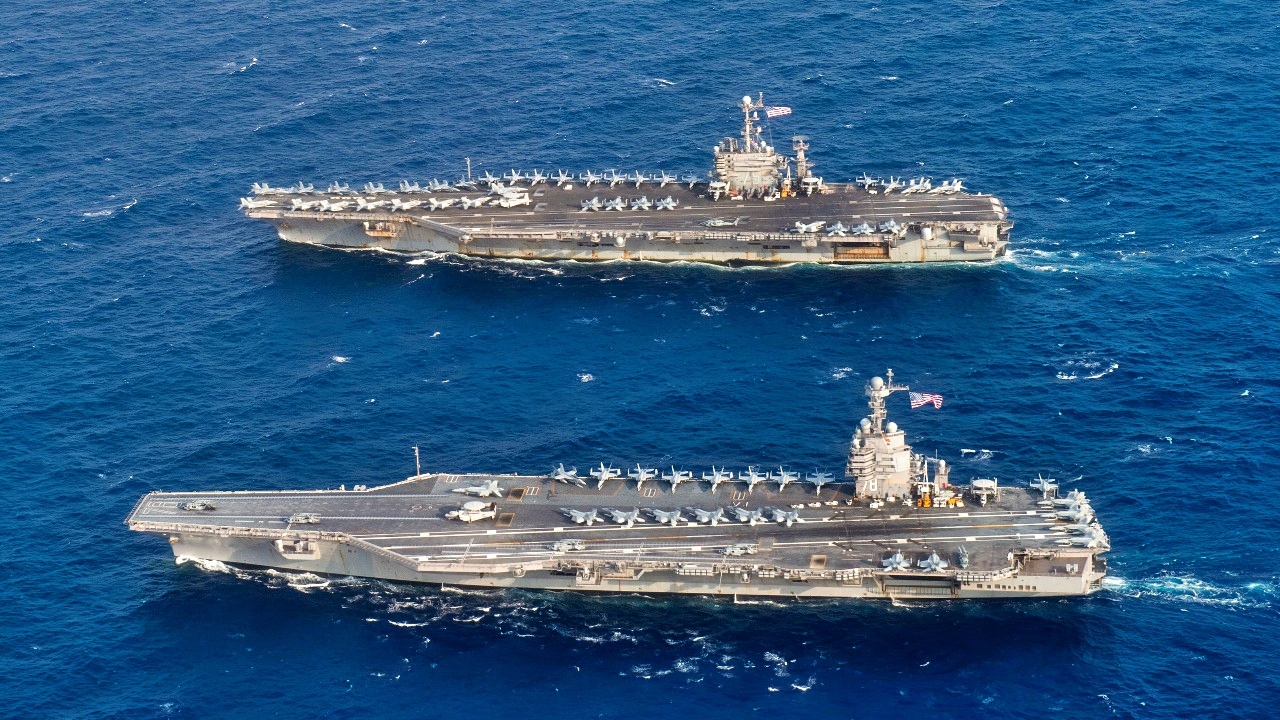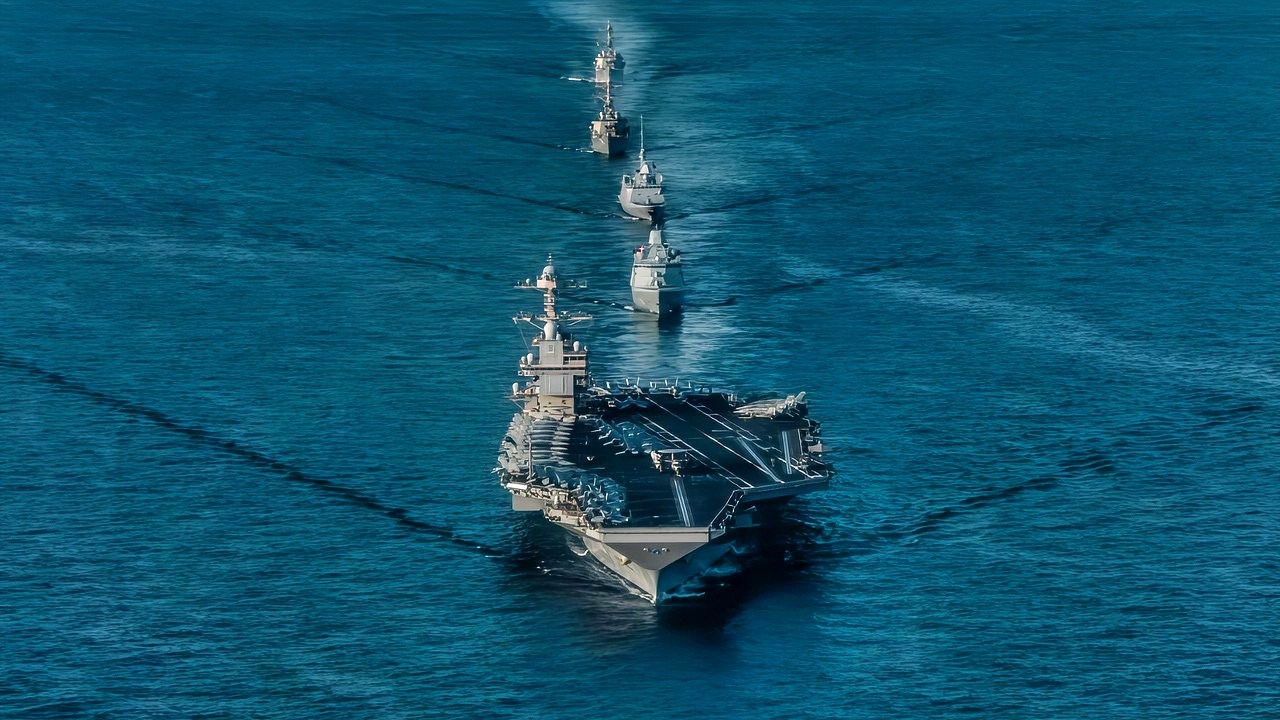Key Points and Summary – The USS Gerald R. Ford (CVN-78), the U.S. Navy’s next-generation supercarrier, was plagued by massive delays and cost overruns due to a “unrealistic” acquisition strategy.
-The core problem was the decision to build the ship while 23 of its new, critical technologies were still immature.

The Ford-class aircraft carrier USS Gerald R. Ford (CVN 78) and the Italian aircraft carrier ITS Cavour (CVH 550) transit the Atlantic Ocean March 20, 2021, marking the first time a Ford-class and Italian carrier have operated together underway. As part of the Italian Navy’s Ready for Operations (RFO) campaign for its flagship, Cavour is conducting sea trials in coordination with the F-35 Lightning II Joint Program Office’s Patuxent River Integrated Test Force to obtain official certification to safely operate the F-35B. Gerald R. Ford is conducting integrated carrier strike group operations during independent steaming event 17 as part of her post-delivery test and trials phase of operations.
-This led to a 23% cost increase ($12.9 billion total) and years of delays as essential systems—like the Electromagnetic Aircraft Launch System (EMALS), Advanced Arresting Gear (AAG), and Advanced Weapons Elevators (AWEs)—suffered major reliability failures and required extensive debugging long after the ship was commissioned in 2017.
USS Gerald R. Ford Aircraft Carrier – Why It Was Delayed
The USS Gerald R. Ford (CVN-78) is the U.S. Navy’s most advanced and ambitious aircraft carrier yet.
It’s the lead ship of the Ford-class, intended to usher in a new generation of power-projection in the form of nuclear-powered strike capability.
From the very beginning, the vessel has promised several major technological leaps that will advance America’s naval power.
It offers improved sortie generation, enabling military aircraft to complete missions and return to the air more frequently, quickly, and efficiently.
It also boasts a reduced crew size thanks to improved automation and integrates several new cutting-edge systems, including electromagnetic catapults (EMALS) and advanced weapons elevators.
The vessel’s path into service, however, has not been smooth.
The program has endured significant cost overruns, schedule delays, and recurring problems with new technologies—including the EMALS launch system, advanced arresting gear, and its new weapons-elevator system.

The Ford-class aircraft carrier USS Gerald R. Ford (CVN 78) and the Italian aircraft carrier ITS Cavour (CVH 550) transit the Atlantic Ocean March 20, 2021, marking the first time a Ford-class and Italian carrier have operated together underway. As part of the Italian Navy’s Ready for Operations (RFO) campaign for its flagship, Cavour is conducting sea trials in coordination with the F-35 Lightning II Joint Program Office’s Patuxent River Integrated Test Force to obtain official certification to safely operate the F-35B. Gerald R. Ford is conducting integrated carrier strike group operations during independent steaming event 17 as part of her post-delivery test and trials phase of operations. (U.S. Navy photo by Mass Communication Specialist 3rd Class Riley McDowell)
These failures have hindered the ship’s readiness and raised serious questions about the Navy’s ability to acquire these crucial new assets.
The Navy’s Next-Generation Flagship
Commissioned on July 22, 2017, the USS Gerald R. Ford is the lead ship of the Ford-class of nuclear-powered aircraft carriers, marking the first new U.S. carrier class in more than 40 years.
Built to replace the Nimitz-class, the new class of carriers is packed with innovations and technological advancements in propulsion, ship systems, and air-wing operations. For example, the Ford-class carries a displacement of roughly 100,000 tons and a length of around 1,100 feet.
The ship was designed with an essential operational vision: to deliver a significantly higher aircraft sortie generation rate, a smaller crew optimized by automated systems, and more power and electrical generation capacity sufficient to operate increasingly advanced technological hardware for the next several decades.
U.S. Navy design statements reveal that the carrier is designed to achieve as many as 160 sorties every 12 hours, and surge up to 270 sorties in 24 hours.
That, when compared to the roughly 120 sorties of the last generation of vessels, is a significant improvement.
The Ford-class also introduces new A1B nuclear reactors, the Electromagnetic Aircraft Launch System (EMALS), and Advanced Arresting Gear (AAG), all of which are aimed at achieving faster, smoother aircraft launch and recovery.

Ford-Class. Image Credit: Creative Commons
Additionally, the weapons-handling systems and deck systems have been completely redesigned.
The Advanced Weapons Elevators (AWEs) can move heavier loads at higher speeds.
All of these advancements are aimed at improving performance, reducing manpower, and making maintenance easier while lowering the associated costs. But these benefits have been hard-fought for.
What Went Wrong?
The Ford-class offers so much promise, but has been plagued by delays and problems.
Those struggles stem primarily from the decision to field new technologies on board the vessel at the same time the lead ship was being built, meaning that the ship’s onboard systems were not thoroughly planned or mapped out before construction began.
That decision resulted in significant cost growth, schedule slipping, and even changes to capabilities.
The Government Accountability Office (GAO) noted that when construction of CVN-78 began, it was described as “unrealistic” in the sense that costs had been underestimated and critical technologies had not fully matured.
The GAO also notes that the lead ship’s cost grew by nearly 23 percent, with procurement estimates around $12.9 billion USD for CVN-78—more than the initially estimated $ 10.5 billion.
Schedule delays then followed, and although the carrier was commissioned in July 2017, its full operational capability was then delayed for many years.
It was, then, the technical readiness—or lack thereof—of technological and core systems that drove most of the delay.
The new EMALS systems and AAG experienced major reliability issues in the early days, preventing the carrier from meeting its intended sortie-generation targets.
Then there were delays and problems with the advanced weapons elevators, intended to improve the flow of ordnance across the carrier.

The U.S. Navy Gerald R. Ford–class aircraft carrier USS Gerald R. Ford (CVN-78) and the Nimitz-class aircraft carrier USS Harry S. Truman (CVN-75) underway in the Atlantic Ocean on 4 June 2020, marking the first time a Gerald R. Ford–class and a Nimitz-class aircraft carrier operated together underway.
The systems were multiple years behind schedule for installation and certification, and testing and integration were forced to proceed concurrently with construction.
That meant that the final setup and trials overlapped with significant parts of ship assembly, complicating both efforts and leaving a tiny margin for error.
Add to this the fact that the project required additional labor, employed new construction techniques, and even underwent significant design changes partway through, and it’s clear why the delays occurred.
Despite the delays, the USS Gerald R. Ford is now finally fully operational, having completed its first global deployment in 2023.
Despite its troubled beginnings, the aircraft carrier is proof that American innovation is very real—even if there’s room for improvement in planning.
About the Author:
Jack Buckby is a British author, counter-extremism researcher, and journalist based in New York. Reporting on the U.K., Europe, and the U.S., he works to analyze and understand left-wing and right-wing radicalization, and reports on Western governments’ approaches to the pressing issues of today. His books and research papers explore these themes and propose pragmatic solutions to our increasingly polarized society. His latest book is The Truth Teller: RFK Jr. and the Case for a Post-Partisan Presidency.
More Military
The ‘Super’ B-52J Stratofortress Bomber Is Coming
The Air Force’s ‘New’ B-1B Lancer Super Bomber Is Coming Soon
‘Flying Dorito’: The A-12 Avenger II Stealth Bomber Summed Up in 1 Word
Never Finished: USS Illinois Is the U.S. Navy’s ‘Scrapped’ Iowa-class Battleship










